All That Technology Makes Us Quicker, But...

06/17/2022
...sometimes quickly, technology turns out to be both a blessing and cursing. You know how we are so technologically nimble we can turn on a dime?
FOUNDATIONS
As I have mentioned before, I do sessions, often remote work a little like Tim Pierce does. People send me tracks and I sweeten them with guitars, synths, new drums, etc., and often mix them as well. Wednesday I had a typical scoring session involving a two-minute, humorous Country & Western tune to go in the middle of a show. At bedtime Tuesday night I received a listen copy of the song for Wednesday and instructions: supply guitar, bass, and synth strings to sweeten the song. I listened on my laptop and heard that the song was based around acoustic guitar that had already been recorded. My load out for Wednesday morning was a Helix modeler and a 2013 Fender American Standard Telecaster*.
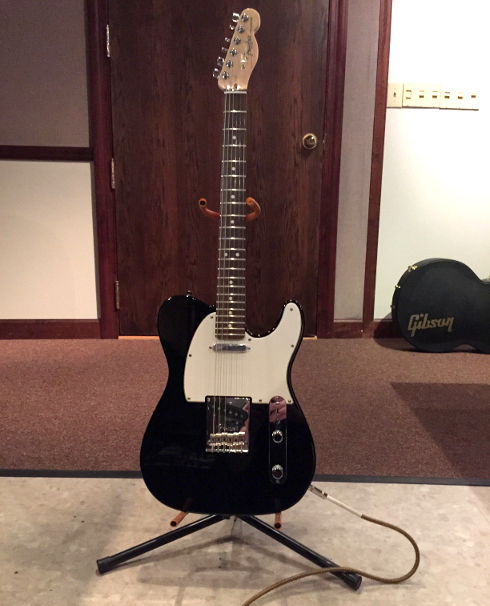
I set up a project using the stereo demo track as a reference and added two measures of click at the top to give me enough time to punch record and then get set to play an instrument. I played the song through a couple of times to learn it and then dived in.
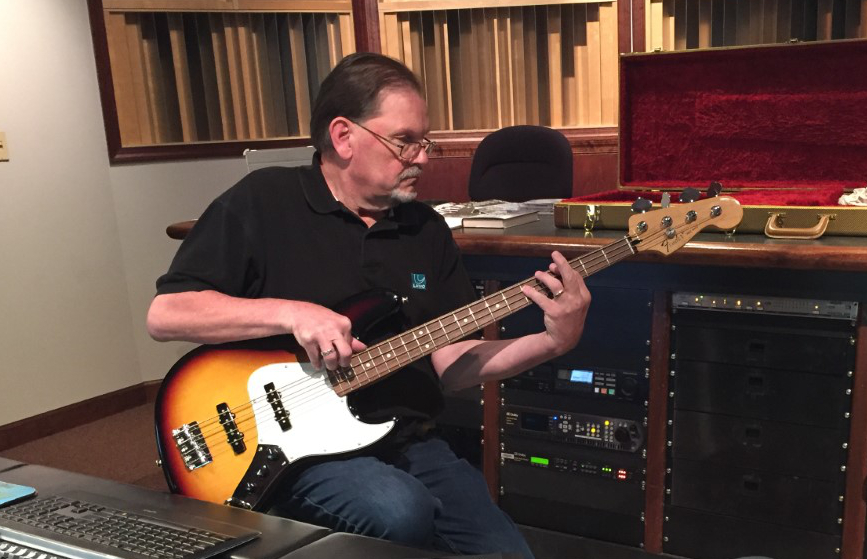
Overdubbing started with me playing the bass parts on a Fender Jazz bass run directly into an Avalon 737 tube preamp, pushing into the onboard tube compressor just a little to increase consistency. I followed up with the Tele, exactly doubling the bass line like they often did in old Country & Western songs. I used the Tele's bridge pickup and palm muted to get just the initial twang. I chose the Helix's Fender Deluxe Reverb Normal Channel model. I put a compressor before the amp and an EQ after it because I've noticed that the Helix presets sound a little thin in the middle. I chose a Fender Twin cab model with Jensen speakers and select the Neumann U-47 mic model. I ran the amp relatively clean with the compressor gain makeup pushing it until the overtones blossomed. Next, I added brushed, chimey chord accents under the song's choruses. The verses needed some "oomph" so I strummed the Tele under them.
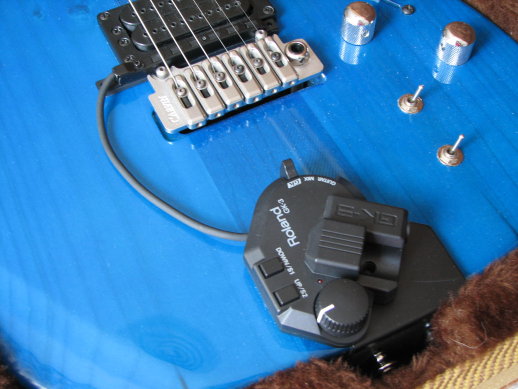
A STRINGY THING
Then I moved over to the Roland synth guitar rig for strings. The pickup is mounted on a Carvin TL60T. I selected a preset with dark strings and created some appropriate chord pads to add to the song's development in two places. I've found that things sound a little better if I initially only play intervals instead of chords and then add the remaining layers separately, sometimes with a different preset. I finished up the strings in time to knock off for lunch with the repair engineers in the shop.
After lunch I came back into the studio and gave the project a fresh listen. It just seemed to need a little more polish to get across the goal line. There were three places where it begged for lead fills to make the passages seem more complete. I switched back to the Tele and Helix and added gain and a touch of echo and reverb. I composed and recorded an intro and fills for the song. Voile'! It felt finished. I sat back and enjoyed a playback of the finished product.
COMPLICATIONS
And then I checked my email. Curses! Here is where our technological ability to turn on a dime turned on me. The composer decided to change horses in the middle of the stream and dropped a new version of the song into the cloud during lunch! I remember when remote working started a decade ago. I read an article in Mix Magazine where Mr. Bonzai extolled the virtues of mixing songs for an album, sitting on a beach while on vacation in Hawaii. At the time, I predicted that this course of immediacy in the work environment might not end well. As it has turned out, immediate turn-around work like film and video often involves getting clobbered with mid-stream or last-minute changes. As a professional, your job now includes going with the flow and making creative changes to conform with the director's/producer's/composer's desires. You don't have to like it, but you do have to be cheerful to your colleagues. However, I've got my own theorem to describe the effect on morale: "Crew morale varies inversely with version number." That means that as the project's version numbers climb, crew morale falls. But we are professionals so get over it.
I loaded the files into my DAW and immediately had to deal with synch issues in the new version. After a bit of trial and error I snapped his files to a beat that made them synch and we were off. First change? The acoustic guitar track that the composer recorded was actually a keyboard sample that he wanted me to replace with actual strumming. With my choice of guitars, the Taylor 710ce dread, still at home, I fell back on the Taylor 314kce GA I keep at the studio and started learning the parts. Once I was comfortable, I took a quick trip to the mic locker to grab my small diaphragm condensers and... Curses! Foiled again! Another engineer had borrowed the matched mic pair assigned to my suite for another project. I tracked down the case in another studio and discovered that a vital adapter that is part of the stereo mic bar was missing. I went through the mic closets of the other studios but couldn't find the part. By the time I gave up on finding it my day was over. But perhaps it was for the better...
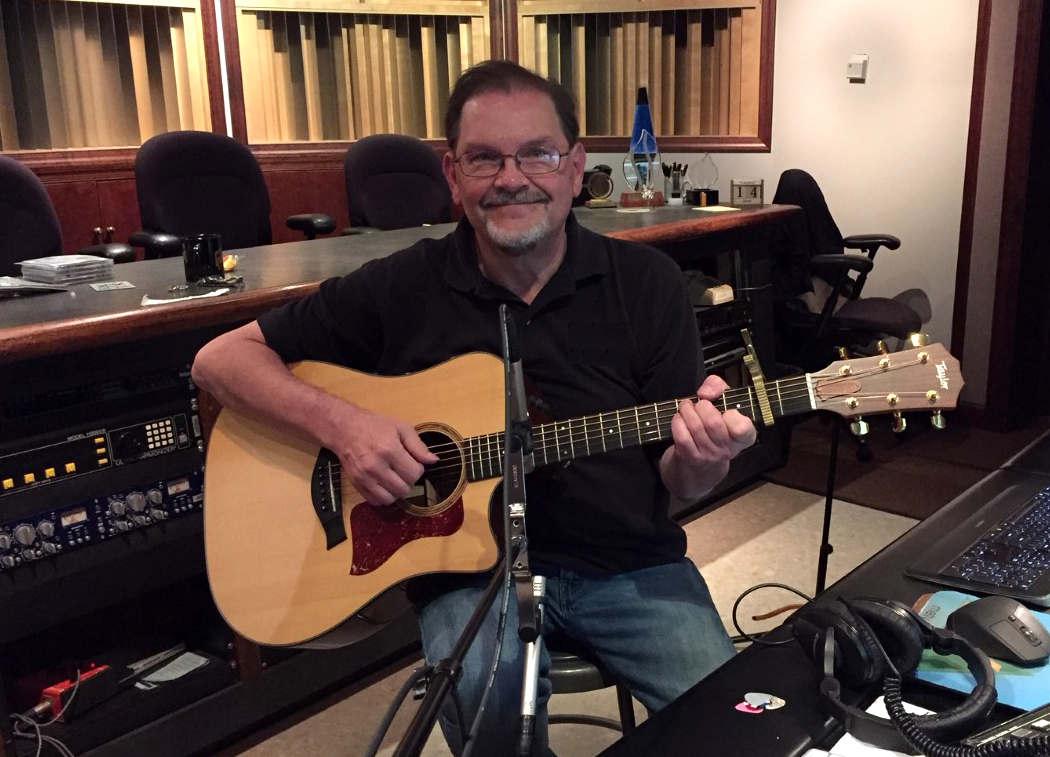
RESOLVE
The next morning I brought into the studio the Taylor 710ce dreadnought*, with rosewood back and sides and an Engelmann spruce top, and my personal stereo mic bar and set about finishing the overdubs. Because our control room is designed to be extremely quiet and to prevent standing waves, I put together my recording rig right in front of the console so I could play and control the audio workstation easily. I assembled my vertically-oriented "inverse OTRF" mic pair and pointed the array at the neck joint from about ten inches away.
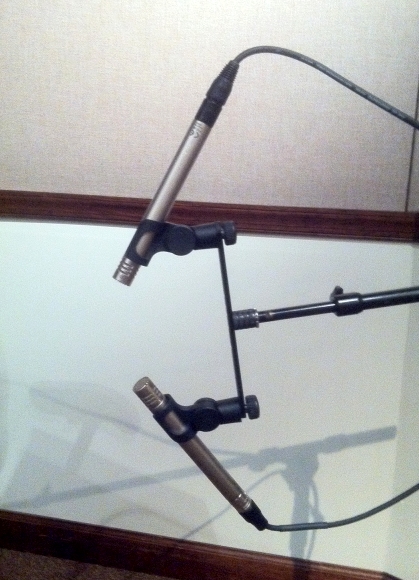
I strummed the parts up there in the same region of the neck with a thin pick to get the crisp, brushing sound I wanted. Horrors. A thin pick. But it worked. All the tracks needed was a little bottom-end roll-off and they sounded perfect in the context of the ensemble. In the studio, the 710ce is a fantastic strumming machine. With the tracks laid down, I spent some time building up a rough mix so the composer could preview my work. I exported and sent it off to the composer via WeTransfer. Now I'm waiting to get his review and okay so I can move on to the next cues.
* Both guitars are fresh out of the garage after being wonderfully set up by my luthier/tech Kenny Marshall.
= =
=






